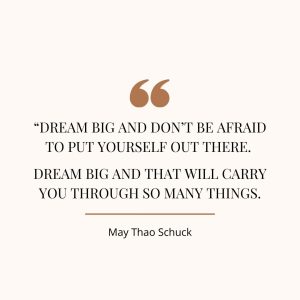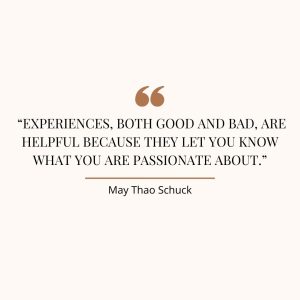The Compass is a new guided experience for current and future students that promotes students’ ability to build a meaningful life. Learn more about the goals of the Compass in Career Development’s interview with Provost Anita Thomas, The Compass: Transforming the Future for St. Kate’s. An important part of this new initiative involves career readiness in the form of a Career Path outlined for students and the Career Competencies. The Career Competencies are the skills that employers look for students to have when applying for internships and jobs.
May Thao-Schuck Reinventing Career Readiness Initiatives at St. Kate’s

May Thao-Schuck has a background in economic development, human development, and running human operations.
She has been the Vice President of Career and Professional Development for two years, playing a major role in the development of the Compass and the Career Competencies.
Vice President May Thao-Schuck chose to work at St Kate’s because it really focuses on reflection, and leadership, pushing students to find something they are really interested in and talking about the impact in the world of their interests. The lens of a woman’s perspective really has an impact on the kind of work the Career and Professional Development Office does as well. Vice President Thao-Schuck wanted to grow the passion for reflection and leadership at St. Kate’s and use it to help students find what they are passionate about.
Being the Vice President of Career and Professional Development and her work.
The goal of both the Compass and the Vice President’s job is to promote meaningful work, which is helping students do what they care about, and get paid! The way success is traditionally regarded in universities is by helping students to obtain a degree. Success in relation to the Compass entails a variety of aspects: getting a degree, pursuing a career in an area that students care about, getting appropriately compensated for the work provided, and having the opportunity to grow.

My Career Path
My Career Path is the career component of the Compass and identifies the steps to take on their career journey, helping to guide students based on their career readiness, not just on linear progression. This path is set up in stages in order to make this process more simplistic, with hopes of avoiding bombarding students with a million competing priorities. The goal is to meet students where they are, starting with reflection and helping students demonstrate their understanding of their career readiness.
Another key component of My Career Path is that it connects students’ classroom experiences and helps them to build their Competencies. By asking them to demonstrate specific experiences, My Career Path builds on where students are and incorporating their strengths. The Path allows students to track relevant skills and progress to be able to then tell a story about the experiences they have.
My Career Path Approach
My Career Path prepares students to take the next steps into the workforce fully prepped with relevant experiences.
The first year of this experience is all about exploration and helping students identify what they are interested in, in addition to helping them build a career foundation. This entails learning the basics of a resume, cover letter, and LinkedIn to ensure that students start off strong in their career journey.
In the second year, students will focus on building connections to their interests and to others. One area the path focuses on is providing mentorship opportunities where students have the chance to participate in job shadow experiences, along with learning to develop how they talk about themselves. In these mentoring opportunities, students work on building career competencies such as creativity, innovation, professionalism, collaboration, and adaptability.
Once students have those career-related experiences, their third year delves into their discipline and how to develop in their desired field. This year emphasizes asking the right questions: What things should students know about? How should they develop their skills through internships, practicums, or fieldwork? How can they properly use the competencies they learned?
The last steps of the path are dedicated to accelerating and growing students’ networks, and being prepared for the job market. It emphasizes relationship building, in addition to students knowing who they are and being able to share that information.
By learning the career competencies that My Career Path teaches, students will be able to expand their connections and experiences with others. These connections are vital in students’ career journey, as the majority of jobs are not posted. For this reason, it is even more important for students to network and be ready to talk about what they care about. Expanding their network and using career resources, like Linkedin, prepare students to communicate their vocational skills.
The Value of the Competencies
One of the most impactful aspects of My Career Path centers around the career competencies. The most important competencies according to Vice President Thao-Schuck are critical thinking and decision making, leadership and collaboration, and career management and adaptability. These skills allow students to work professionally with others, along with employing creativity and innovation in the workplace. The inclusion of innovation and creativity as competencies allows students the ability to think strategically and solve problems.
Digital and technology application has been increasingly more important as work moves to remote platforms and companies look to examine analytics. This change in work dynamic means that competencies, such as flexibility and embracing change are vital in employees, which can be seen in the My Career Path competencies of career management and adaptability. Career management and adaptability focus on students being able to identify and articulate their knowledge, skills, and strengths and use those strengths to learn and grow in different work environments as students advance their career paths.
Resources for Students
Resources that are recommended for St. Kate’s students include Handshake, PathwayU, Career Activator, and connecting with the Career Development Office. Handshake is useful for students as they can job search, make appointments, and get notified of career-related events. PathwayU is a career assessment that is based on values, interests, and work preferences that connect students to different opportunities. Career Activator helps with the basics of a resume and cover letter.
Connection with the Classroom
The Compass, My Career Path and the career competencies are designed to connect with students’ coursework. This allows them to spend the most time in the classroom and avoid taking on additional responsibilities.
This partnership is likely to happen in accordance with faculty. Faculty are able to help students reflect on what they learned, and what competencies they practiced in a more in-depth approach as they are knowledgeable about their fields.
Skills in any course have a connection to the competencies. In a communications class when students identify an audience and create messages that foster understanding they are practicing communication, critical thinking, and global and intercultural fluency. When an art student provides feedback to fellow students in a critique they are practicing communication, professionalism, and leadership. All courses lead to career growth.
Students are spending most of their time in the classroom, so incorporating the Compass into the course curriculum allows students to work on both their education and their professional experience. The framework allows students to think and reflect on what they learned and why it’s important, and how it is useful for their future.
St. Kate’s Vision for Success
St. Kate’s vision of success is about helping students to discover what they are interested in and connecting them with opportunities. This allows students to build their social capital and grow their network. The goal is to help students understand what they bring to the table and how they can impact the world.
Success is providing students with a clear goal of where they want to go. It doesn’t have to be specifically what they want to do with their lives but rather how they can better shape their future to be the life they want to live. The Compass is vital because it is a partnership and a guide that students can use for further development, both professionally and personally.


